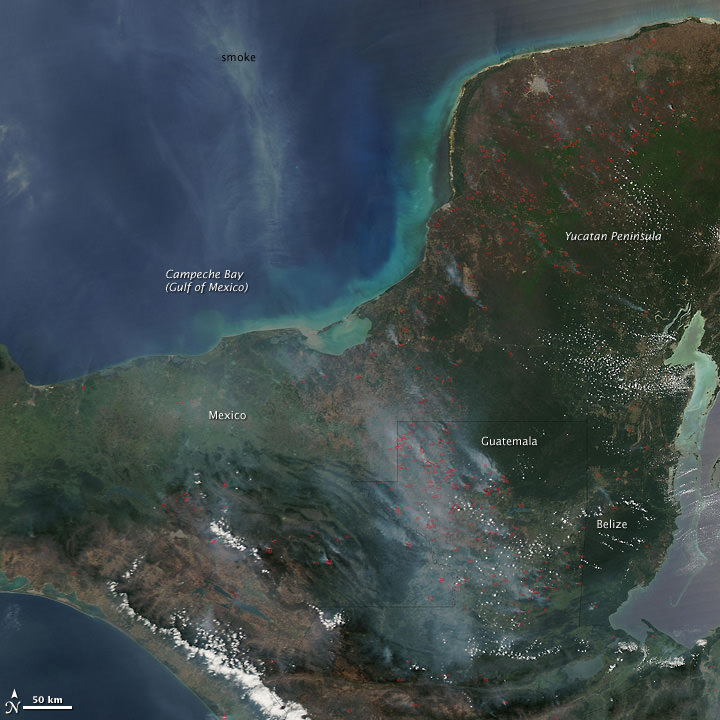[/caption]
Having just read about the deadly wildfires in Texas and Oklahoma, I was interested to see whether one of NASA’s Earth-monitoring satellites have been tracking the situation from orbit. Whether it is too early for observations to come in, or whether one of the satellites have yet to make a pass directly above the states it is unclear, but along the way I noticed a rather striking image of the Yucatan Peninsula, Central America. In the picture retrieved by NASA’s Aqua satellite are countless wildfires dotted over Mexico, Guatemala and Honduras. It looks like a combination of arson, agricultural activity and accidental blazes are gripping the region, fuelled by dry vegetation…
As tornadoes turn parts of Arkansas into “warzones”, Texas and Oklahoma are dealing with wildfires. Although these states are no stranger to fires, the continuing drought in the southern US states are causing these fires to rage over larger areas for longer periods. Southern California is also sustaining a three-year drought, and in 2008 just north of LA (where I’m located), it seemed that a week didn’t go by without smelling smoke in the air. In fact, at one point, the wildfires burned worryingly close to where I live, filling the house with smoke at 5:30am one morning. Fortunately, we were the lucky ones, but others weren’t so fortunate and fell victim to the direction of the wind, losing property and, in some tragic cases, their lives. Unfortunately, all predictions are that if 2009 is going to be as dry as last year, SoCal will bear the brunt of another round of wildfires, and hearing bad news from Texas and Oklahoma is an uneasy reminder of things to come.
However, on browsing NASA’s Earth Observatory website, it looks like our neighbours are having a hard time with wildfires too. Hundreds of fires were burning at the start of this month, but many didn’t have a natural beginning.
On viewing the imagery from the Moderate Resolution Imaging Spectroradiometer (MODIS) instrument on board the Aqua satellite, it is hard to comprehend the scale of the wildfire-affected region. MODIS can detect areas of intense heat, allowing NASA’s Earth Observatory program to pinpoint the location and scale of burning vegetation. Red spots (fires) cover southern Mexico, on the Yucatan Peninsula, and in northern Guatemala and northern Honduras and smoke hangs over Campeche Bay in the Gulf of Mexico. This scene isn’t just caused by dry weather, it is a symptom of the pressure being applied to the tropical region by human activity. Land is at a premium in these developing regions of the world, so there is a need for farmers and loggers to clear vast areas of land to economise on the dry conditions to spread the fire. November to May are particularly difficult months as this is central America’s dry season.
Conservationists are on the look-out for accidental fires, but there is always the problem of intentional fires too. As farmland becomes scarce or access to prime logging forests becomes difficult, arson becomes a huge problem.
Fortunately, modern technology is helping countries to locate fires in real-time before they have a chance to spread. MODIS data is fed into the Fire Information for Resource Management System (FIRMS) and had users in 60 countries only months after the system was set up in 2006. Land managers and conservation groups in Central America receive messages via mobile phones and email should a fire be detected in their region, so hopefully the risk of large-scale damage can be limited.
Source: Earth Observatory


‘Conversationalists are on the look-out for accidental fires’ – oops… Never mind, we knew what you meant and good story anyway, but worrying.
What a great way (photographically) Ian, to communicate and visualize the immensity of the problem at various locations around the world. Orbiting Earth-observing satellites may be one way to inform the layperson of the reality and scope of the problem!
How does ‘drill baby drill’ sound like ‘burn baby burn’? Same tree, different monkey?
When I worked in Costa Rica in early 1990, setting fire to the forest during Semana Santa (Holy Week) around Easter was a tradition in Guanacaste Province that we tried to combat with education, as well as fuelbreak construction and removal of flammable invasive grasses.
The site seems back on track for now, though. Fingers crossed.